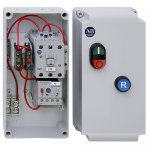moldingppmm
Member
- Location
- United States
Hello all.
I'm having a issue with a motor in my shop.
I have an injection molding shop that has a pump that circulates water to the machinery. A few years ago, the motor that was on the pump went, so I ended up going out and buying a new one.
Everything was fine until the last few months. I've been having a lot of issues with my electrical service over the years, mostly when we get any weather that starts with gusts of wind and up, we single phase really bad. As winter has started, I've had this motor blow the windings twice already...in 4 weeks. I've lowered the fuse amps, which didn't help when I phased last night. So here I am, with another blown up motor.
I don't know much about motor circuits but, I'm assuming that my overload needs readjusted or I need a smaller one. Am I correct with this? I really can't afford $600 every 2 weeks.
Info from the motor:
Weg Model: 007360T3E184JM
7.5 HP
That's all I can read on the motor, I'll post a grainger link below that has the info...
Link to Grainger: http://www.grainger.com/product/WEG-Pump-Motor-4EUU2
If it doesn't come up, it's #4EUU2
Thanks for the help in advance...I appreciate it.
I'm having a issue with a motor in my shop.
I have an injection molding shop that has a pump that circulates water to the machinery. A few years ago, the motor that was on the pump went, so I ended up going out and buying a new one.
Everything was fine until the last few months. I've been having a lot of issues with my electrical service over the years, mostly when we get any weather that starts with gusts of wind and up, we single phase really bad. As winter has started, I've had this motor blow the windings twice already...in 4 weeks. I've lowered the fuse amps, which didn't help when I phased last night. So here I am, with another blown up motor.
I don't know much about motor circuits but, I'm assuming that my overload needs readjusted or I need a smaller one. Am I correct with this? I really can't afford $600 every 2 weeks.
Info from the motor:
Weg Model: 007360T3E184JM
7.5 HP
That's all I can read on the motor, I'll post a grainger link below that has the info...
Link to Grainger: http://www.grainger.com/product/WEG-Pump-Motor-4EUU2
If it doesn't come up, it's #4EUU2
Thanks for the help in advance...I appreciate it.
Last edited by a moderator:

